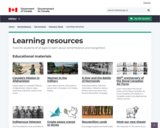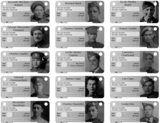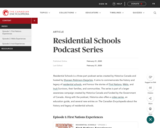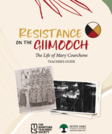
Remembrance Day learning activities and lesson guides for ages 5 to 18.
- Subject:
- History
- Social Studies
- Material Type:
- Activity/Lab
- Homework/Assignment
- Author:
- Veteran's Affairs Canada
- Date Added:
- 10/25/2018

Remembrance Day learning activities and lesson guides for ages 5 to 18.

A lesson to increase youth awareness of Indigenous people who served in the Canadian military and died in service over the years.
Everything is provided.

Indigenous people have a long and proud tradition of military service in Canada. From the earliest days before Canada was even a country of its own, through through the First and Second World Wars, the Korean War, post-war peace support efforts, Afghanistan and on to the present day, thousands of First Nations, Métis, Inuit and other Indigenous men and women have served bravely and well in uniform.

In which John Green teaches you about the European Renaissance. European learning changed the world in the 15th and 16th century, but was it a cultural revolution, or an evolution? We'd argue that any cultural shift that occurs over a couple of hundred years isn't too overwhelming to the people who live through it. In retrospect though, the cultural bloom in Europe during this time was pretty impressive. In addition to investigating what caused the Renaissance and who benefitted from the changes that occurred, John will tell you just how the Ninja Turtles got mixed up in all this.

Residential Schools is a three-part podcast series that aims to honour the stories of First Nations, Métis, and Inuit Survivors, their families, and communities.

This resource examines:
*The purpose of residential schools
*The assaults and their legacy
*Resistance and change
*Action for reconciliation
*Case studies
*Resources

This resource examines:
*Setting the stage for inquiry
*150 Years' relationship
*Research
*Resources

Residential schools were boarding schools for Indigenous (First Nations, Inuit and Métis) children and youth, financed by the federal government but staffed and run by several Christian religious institutions. Children were separated from their families and communities, sometimes by force, and lived in and attended classes at the schools for most of the year. Often, the residential schools were located far from the students’ home communities. The schools were in existence for well over 100 years, and successive generations of children and families from the same communities endured this experience.
Understandably, the impacts were severe. This history was hidden for many years, until Survivors of the system were able to find the strength and courage to tell their stories. This lead to one of the largest class action lawsuits in Canada’s history. Though it will take time and commitment to heal the relationship between Indigenous Peoples and Canada, the reconciliation process has begun.

This impactful work is based on the Life Story of Elder Mary Courchene during her time in Residential Schools that channels her story of truth, resistance, healing and the reclamation of identity, language, culture and community for herself and her family. We are incredibly proud of this work and are excited to share it with everyone.
We see this curriculum as a living document to be used throughout the school year to help students (and staff) better understand the impacts of Residential Schools. The hope is for classrooms to engage in multiple lessons over a period of time, versus the one-day event to honour Orange Shirt Day.
The curriculum is for middle and senior years level but many pieces can be used and adapted for early years. Elder Mary's story is one of resistance, healing and love. Her truth is a gift to all that will both preserve her story and honour her life's work as an educator and elder who has always so generously shared her story so that children, youth and adults can learn truth and walk the path of reconciliation. We recognize how impactful it will be for all schools across Manitoba and Canada, to have a resource such as this one, Resistance on the Giimooch (Giimooch in Anishinaabemowin means in secret).

Resources for Rethinking. provides immediate access to more than 1200 quality classroom resources.
Developed by Learning for a Sustainable Future, R4R.ca connects teachers to lesson plans, books, videos and other materials that explore the environmental, social and economic dimensions of important issues and events unfolding in our world today. R4R resources have been reviewed by experienced classroom teachers and matched to relevant curriculum outcomes for each province and territory. Use the search engine to find resources and read the reviews. Most of these materials can be downloaded immediately.
To begin: Select your province on the right side of the screen. Add any other filters you wish to explore to narrow your search and have fun exploring the amazing resources!

"Ressources pour repenser de L'éducation au service de la Terre (LST) est votre base de données en ligne pour des ressources pédagogiques de qualité sur le développement durable ! Toutes nos ressources sont révisées par des enseignants pour des enseignants, adaptées à votre programme d'études et disponibles gratuitement ou à faible coût."
Ressources pour la Réflexion offre un accès immédiat à plus de 1200 ressources pédagogiques de qualité.
Développé par Learning for a Sustainable Future, R4R.ca met en relation les enseignants avec des plans de cours, des livres, des vidéos et d'autres supports qui explorent les dimensions environnementales, sociales et économiques des problèmes et événements importants qui se déroulent dans notre monde aujourd'hui. Les ressources de R4R ont été examinées par des enseignants expérimentés et associées aux résultats pertinents du programme d'études pour chaque province et territoire. Utilisez le moteur de recherche pour trouver des ressources et lire les critiques. La plupart de ces matériaux peuvent être téléchargés immédiatement.
Pour commencer : Sélectionnez votre province du côté droit de l'écran. Ajoutez d'autres filtres si vous souhaitez affiner votre recherche et amusez-vous à explorer ces ressources incroyables !

« Les organismes suivants ont établi des partenariats avec le RESSC [Réseau pour l’enseignement des sciences sociales du Canada]. Ils offrent une gamme de services et de ressources aux enseignantes et enseignants. Nous avons fourni des liens vers certaines de leurs ressources numériques. »
-ESRI Canada (systèmes d’information géographique (SIG))
-Le Centre Samara pour la démocratie - Les Personnages de la Chambre
-Croix-Rouge canadienne - Webinaire sur les enfants affectés par la guerre
-Le Centre Juno Beach - Le séminaire d’été et circuit des champs de batailles
-CIRANO - Outils financiers
-Le Centre Diefenbaker du Canada - La citoyenneté engagée
-Action Canada - Cours Politiques 101
-Moments Déterminants Canada - Webinaire sur la résistance et la résilience des populations autochtones, Tous pour 9 et 9 pour tous
-Musée de l'Holocauste de Montréal - Programmes virtuels et ressources bilingues
-The/La Collaborative - Visites de spécalistes et experts en salle de classe
-Not About Me (documentaire - mondialisme et citoyenneté)
« Le Réseau pour l’enseignement des sciences sociales du Canada a comme mission de promouvoir l’enseignement des sciences sociales de haute qualité et d’accroître les capacités à cet effet en favorisant le réseautage entre enseignantes et enseignants et en collaborant avec des partenaires de partout au Canada. »

"Accessibles partout et en tout temps, les ressources en ligne sont une solution avantageuse pour les élèves, le personnel enseignant et le personnel des divisions scolaires. Accédez à plus de 15 000 revues, magazines, journaux, répertoires en ligne, encyclopédies et livres numériques en plein texte ainsi qu'à d'autre matériel de référence en ligne et des services de diffusion de vidéos en continu uniques. Ces ressources sont accessibles à partir de votre établissement scolaire ou dans Internet avec votre code de connexion EDonline ou celui de votre école. Pour apprendre comment utiliser ces ressources en ligne, visitez la bibliothèque de votre école ou votre bibliothèque publique locale."
Directives
Authentification: Accès à domicile
Vous accédez actuellement à cette page à partir de l'extérieur d'une bibliothèque ou d'un établissement scolaire de la maternelle à la 12e année de la Saskatchewan. Ainsi, on vous demandera de vous connecter au moyen des identifiants de votre école, de votre division scolaire ou de votre autorité scolaire pour accéder à ces ressources. Vous pouvez également vous connecter avec votre compte de Blackboard Learn.
Remarque: Les bases de données ouvertes ne requièrent pas de code de connexion et le public peut y accéder gratuitement.
Enseignants et étudiants du Sask DLC : pour accéder à ces ressources : 1. Sélectionnez et cliquez sur la ressource à laquelle vous souhaitez accéder, par exemple, CBC Curio. 2. Vous serez ensuite invité à sélectionner votre école, votre division ou votre autorité éducative. 3. Faites défiler vers le bas et choisissez "Sask. Distance Learning Centre". 4. Connectez-vous avec vos identifiants Sask DLC et toutes ces ressources seront à portée de main !
Aboriginal Education Research Centre
Academic OneFile Select
ArcGIS
Auto Repair Source
BBC
Business Source Elite
CBC Curio
CBCA
Canadian Encyclopedia
Canadian Major Daiies
Canadian Points of View
Canadian Reference Centre
Canadian Research Index
Canadiana Online
EXPLORA
Early Canadiana Online
Encyclopedia Britannica
Explore History
Gale in Context
Gale Literature
General OneFile
Health and Wellness
History Reference Centre
IDELLO
LIVE
LegalTrac
National Film Board of Canada
National Geographic Channel
News in Review
NovelList Plus
Our Legacy
PressReader
Rover
Safety Care
Science One
SK History Online
Statistics Canada
The Heritage Project (French)
Universalias Junior & Senior
Virtual Museum of Metis History and Culture

In which John Green returns to teaching World History! This week, we'll be talking about the idea of civilization, some of the traditional hallmarks of so-called civilization, and why some people would choose to live outside the civilization model. It turns out, not everyone who lives outside of what we traditionally think of as a "civilized" social order is necessarily a barbarian! To defuse any tension you may be feeling, I'll just tell you now, the Mongols are back. You'll learn about Zomia, swidden agriculture, and even a little about anarchy!

In this transcript of an interview for Eyes on the Prize, the Reverend C. T. Vivian remembers his leadership role in the Civil Rights Movement and the risks civil rights activists took in challenging segregation.

In which John Green talks about the methods of writing history by looking at some of the ways that history has been written about the rise of the West. But first he has to tell you what the West is. And then he has to explain the Rise of the West. And then he gets down to talking about the different ways that historians and other academics have explained how the West became dominant in the world. He'll look at explanations from Acemoglu and Robinson's "Why Nations Fail," Francis Fukuyama's "The Origins of Political Order," and Ian Morris's "Why the West Rules, for Now."

In this video segment, recorded for Eyes on the Prize, activist Robert Moses talks about the Mississippi voting rights campaign.

This art history video discussion examines Auguste Rodin's "The Gates of Hell" 1880-1917, plaster (Musee d'Orsay, Paris).When the building, earlier on the site of the Musee d'Orsay in Paris, was destroyed by fire during the Commune in 1871, plans were drawn up to replace it with a museum of decorative arts. Rodin won the competition to design a great set of doors for its entry way. Although the museum was never built, Rodin continued to work on the doors. They became an ongoing project; a grand stage for his sculptural ideas. It's fitting that the plaster of this great unfinished sculpture, The Gates of Hell, is now on display at the d'Orsay, the former railway terminal that was built on this site instead of the museum of decorative arts and that, by lovely coincidence, was converted into one of the world's great art museums.

Introducing and highlighting Role Models provides a wonderful, positive way to showcase culture and identity. It is motivating and uplifting to honour and celebrate First Nations men and women who have made and are continuing to make contributions to their communities, their Nation and, in many cases, the world. These Role Models come from different regions of the country. Their personal journeys tell of dedication, effort, leadership, excellence, wisdom, survival, commitment, discipline and a whole lot more. There are examples of lives well lived, and their stories provide lessons for all of us.

"Rompre le silence est un livre interactif du Projet du Cœur de la Saskatchewan qui révèle l'histoire des pensionnats autochtones en Saskatchewan. Rédigé en 2017 par la Faculté d'éducation de l'Université de Regina, ce document explore la réalité des pensionnats en Saskatchewan. Il constitue une excellente ressource pour les enseignants, les étudiants et la communauté, abordant de nombreux sujets et tous les pensionnats de la province.
Cet ebook fait partie du Projet du Cœur, une initiative commémorative qui facilite l'apprentissage des élèves sur les pensionnats autochtones. Le projet est un voyage fondé sur l'enquête, la collaboration, l'intergénérationnel et l'art pour examiner l'histoire et l'héritage des pensionnats autochtones au Canada, conduisant à la reconnaissance des pertes subies par les anciens élèves, leurs familles et leurs communautés.